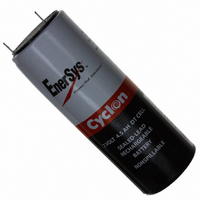0860-0004 EnerSys, 0860-0004 Datasheet - Page 15

0860-0004
Manufacturer Part Number
0860-0004
Description
BATT CYCLON SLA 2V 4.5AH
Manufacturer
EnerSys
Series
Cyclon®r
Specifications of 0860-0004
Voltage - Rated
2V
Capacity
4.5Ah
Size / Dimension
1.35" Dia x 3.78" H (34.3mm x 96.0mm)
Termination Style
Spade, .187" (4.7mm)
Rechargeability
Yes
Weight
0.6 lb (272.16g)
Lead Free Status / RoHS Status
Lead free by exemption / RoHS compliant by exemption
Other names
842-1001
6.9 Taper Current Charging
Although taper current chargers are among the least
expensive types of chargers, their lack of voltage regulation
can be detrimental to the life of any cell or battery. While
CYCLON
charge voltage variations, some caution in using taper
chargers is recommended.
A taper charger contains a transformer for voltage reduction
and a half-wave or full-wave rectifier for converting the AC
input into a DC output. The output characteristics are such
that as the voltage of the battery rises during charge, the
charging current decreases. This effect is achieved by using
proper wire size and turns ratio.
Basically, the turns ratio from primary to secondary
determines the output voltage at no load, and the wire size
in the secondary determines the current at a given voltage.
The transformer is essentially a constant voltage transformer
that depends entirely on the AC (input) line voltage
regulation for its output voltage regulation.
Because of the crude method of regulation, any changes
in input line voltage directly affect the charger output.
Depending on the charger design, the output-to-input
voltage change can be more than a direct ratio. For
example, a 10% line voltage change can produce a 13%
change in the output voltage.
There are several charging parameters that must be
met. The parameter of main concern is the recharge
time to 100% nominal capacity for cyclic application.
This parameter can primarily be defined as the charge
rate available to the cell when the cell is at 2.20 volts
(representing the charge voltage at which approximately
50% of the charge has been returned at normal charge rates
between C
voltage point at which the cell is in overcharge).
Given the charge rate at 2.20 volts, the recharge time for
a taper current charger can be defined by the following
equation:
In the equation above for the recharge time using a
taper charger, C
ampere-hours while C
2.20 VPC. The 1.10 multiplier represents the 5% to 10%
overcharge that is recommended for a complete recharge.
It is recommended that the charge current rate at 2.50
volts be between C
to insure that the battery will be recharged at normal rates
and that the battery will not be severely overcharged if the
charger is left connected for extended time periods.
4
of the depth of discharge.
www.enersys.com
A battery is said to have completed a cycle if it starts out from a fully charged condition, completes a discharge and is then fully recharged, regardless
Recharge time =
®
batteries have a superior ability to withstand
10
/10 and C
D
represents the discharged capacity in
10
/50 maximum and C
2.2V
10
/20) and 2.50 volts (representing the
1.10 x C
is the charge current delivered at
C
2.2V
D
10
/100 minimum
7.1 Introduction
All batteries have extremely variable service life, depending
upon the type of cycle, environment, and charge to which the
cell or battery is subjected during its life. CYCLON batteries are
no exception to this rule. There are two basic types of service
life: cycle life and float life.
7.2 Cycle Life
A cyclic application is basically an application where the
discharge and charge times are of about the same order. The
cycle life of a battery is defined as the number of cycles
battery delivers before its capacity falls below the acceptable
level, usually defined as 80% of rated capacity.
Several factors influence the cycle life available from a battery.
The depth of discharge (DOD) is an important variable affecting
the cycle life. For the CYCLON battery series, the cycle life
expectancy is about 300 full DOD cycles. One can obtain more
cycles with lower depths of discharge as Figure 7-1 shows.
Figure 7-1: Cycle Life and DOD for CYCLON
The quality of recharge is a critical determinant of the life
of a battery in a given cyclic application. In contrast to float
applications where more than adequate time is allowed for a
full recharge, in cyclic applications a major concern is whether
the batteries are being fully recharged in the time available
between discharges. If the recharge time is insufficient, the
battery will "cycle down" or lose capacity prematurely.
In our experience, undercharging is a leading cause of
premature capacity loss in cyclic applications. Although
undercharge and overcharge are both detrimental to the
life of a battery, the time frame over which the effects of
either undercharge or overcharge are felt is very different.
1,000,000
100,000
10,000
1,000
Chapter 7:
CYCLON
100
0
10
®
20
Battery Service Life
Publication No: US-CYC-AM-007 - April 2008
30
Depth of discharge (DOD), %
40
50
Charge profile :
CV @ 2.45 VPC for 16 hours
Current limit at C/10
60
70
®
Battery Cells
80
4
90
a
100
15




















